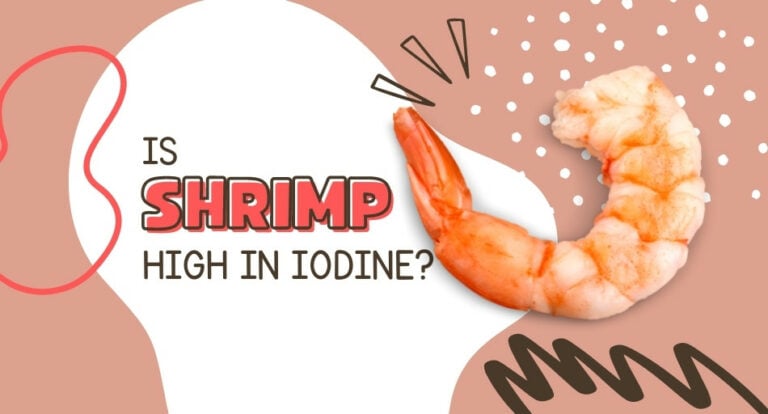Hey there! Ever wondered about the iodine content in those tasty little crustaceans we call shrimp? Well, I’ve done some deep diving into the research and I’m excited to share everything you need to know about shrimp and its iodine content.
Quick Answer
A 3-ounce serving of cooked shrimp contains approximately 35 micrograms (mcg) of iodine. This provides about 23% of the recommended daily intake (150 mcg) for most adults
Detailed Breakdown of Iodine in Different Serving Sizes
Here’s how much iodine you’ll get from different portions of shrimp
| Serving Size | Iodine Content |
|---|---|
| 1 medium shrimp (1 oz) | 11 mcg |
| 3 oz (4 large shrimp) | 35 mcg |
| 6 oz (8-12 jumbo shrimp) | 70-75 mcg |
| 8 oz (12-15 jumbo shrimp) | 90-100 mcg |
Why Should We Care About Iodine?
Lemme tell you why iodine is such a big deal
- It’s crucial for making thyroid hormones
- Helps regulate metabolism
- Supports proper growth and development
- Important for brain function
- Helps maintain healthy energy levels
Different Types of Shrimp and Their Iodine Content
Not all shrimp are created equal! Here’s what we know about different species:
- White shrimp: 35 mcg per 3 oz
- Pink shrimp: 34 mcg per 3 oz
- Tiger prawns: 30-40 mcg per 3 oz
- King prawns: 30-40 mcg per 3 oz
- Rock shrimp: 30-40 mcg per 3 oz
Factors That Can Affect Iodine Levels in Shrimp
A few things can impact how much iodine you’re actually getting:
-
Wild vs. Farm-Raised
- Wild shrimp typically have slightly higher iodine levels
- Farm-raised still provide good amounts
-
Processing and Cooking
- Removing shells reduces iodine slightly
- High-heat cooking might decrease levels a bit
-
Geographic Location
- Ocean conditions affect iodine content
- Different regions may have varying levels
Safety Considerations
While getting iodine from shrimp is generally safe, it’s important to know your limits. The upper tolerable intake levels for iodine are:
- Children (1-3 years): 200 mcg/day
- Children (4-8 years): 300 mcg/day
- Children (9-13 years): 600 mcg/day
- Teens (14-18 years): 900 mcg/day
- Adults: 1,100 mcg/day
Other Nutritional Benefits of Shrimp
Besides iodine, shrimp is packed with other good stuff:
- High-quality protein
- Vitamin B12
- Selenium
- Phosphorus
- Omega-3 fatty acids
- Antioxidants (like astaxanthin)
Tips for Getting the Most Iodine from Shrimp
- Don’t overcook your shrimp
- Consider eating them with shells on when appropriate
- Choose wild-caught when possible
- Store properly to maintain nutrient content
Common Questions About Shrimp and Iodine
Q: Can I get too much iodine from eating shrimp?
A: It’s pretty hard to get too much iodine just from eating shrimp. You’d need to eat A LOT of shrimp to reach toxic levels.
Q: Is frozen shrimp as good as fresh for iodine content?
A: Yes! Freezing doesn’t significantly impact iodine levels.
Q: Should I be worried about mercury when eating shrimp for iodine?
A: Shrimp is actually considered a low-mercury seafood option, so it’s generally safe to eat regularly.
The Bottom Line
Shrimp is an excellent source of iodine, providing about 35 mcg per 3-ounce serving. That’s roughly 23% of what ya need each day! Plus, you’re getting tons of other nutrients along with it. Whether you’re grilling, boiling, or sautéing these little guys, you’re doing your body a favor by including them in your diet.
Would you like me to explain or break down any part of this article in more detail? I’d love to help you understand more about shrimp and iodine!

Iodine, an essential mineral for our bodies
Iodine is one of those nutrients that are essential for our bodies to perform satisfactorily. It is a necessary mineral, and vitally important in the production of thyroid hormones, responsible for regulating our metabolism, among many other purposes.
According to a brochure by the American Thyroid Association, iodine deficiency can be the reason for the appearance of significant symptoms, such as:
However, iodine levels should be monitored, so they do not go beyond certain limits, since the excess of this mineral could also cause health problems. The recommended daily dose is micrograms (µg) varies depending on age and sex:
- Adults, 14 years or older: 100-150 µg per day
- Children younger than 13 years old: 90 µg per day
- Pregnant women or during the breastfeeding period: 290 µg per day
We should add that the human body has neither the ability to produce iodine, nor the capacity to store it. This means that the intake of this particular micronutrient must come from our diet.
5 iodine-rich food items that come from the sea
Most food items that are rich in iodine come from the sea. In the top five we can find seafood and algae or seaweed.
Even though for many fresh cod is at heading the race, truth is that seafood is also ranked very high on the list, according to a database report by the USDA, FDA and ODS-NIH for the Iodine Content of Common Foods. Salted cod, however, does have a higher concentration of iodine; but in any case, here are our top 5 iodine-rich seafood items:
There are many plants and seaweed in the sea, which have high levels of iodine, between 150 and 300 µg /100 g. We are talking about kelp, arame, hiziki, wakame and jambu. Some of these varieties, like kelp, contain over four times the daily dose. This is why a moderate intake is recommended, since excessive iodine can be harmful.
